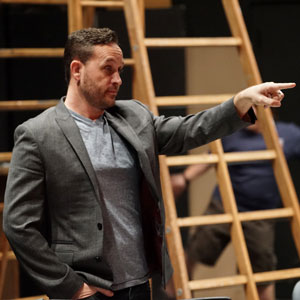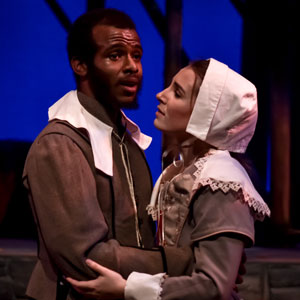FC 'Tartuffe' Raises the Roof
— Fullerton College Hornet - Wes Nease - Wednesday, April 30th, 2008
The Fullerton College production of "Tartuffe" was fated to be a challenge for both the Theatre Department and the audience from its very inception.
Tackling theatric stylizations including classic French farce and Japanese kabuki theatre, Chuck Ketter's goal of stretching the boundaries of Moliere's original production certainly came to fruition under his direction. That challenge coupled with anime themed costuming and the ever universal topic of religious hypocrisy could have easily derailed a production with a weaker cast.
Where pink wigs and outrageous makeup might have proven distracting at the opening of the show, the strength of the cast as a whole was what ultimately made this piece work.
Easily stealing the spotlight at every opportunity, the onstage courtship between Carla Melinna's portrayal of Mariane and Ryan Knight's Valere paid off in spades for this production. Played in perfect farce style, the comedic timing displayed in both performances is thoroughly enjoyable.
Also noteworthy is the performance Ian Getz as Madame Pernelle, the strong showing by Jeffrey Larson as Orgon, and the precise showmanship of Eduardo Baumann as Cleante.
Likewise, the attention to detail in both the set design and construction lend this production more leverage in suspending the disbelief of its audience.
Including floor panels that open and close to provide the cast opportunities for dramatic entrances and exits, strong functionality in the props provide for the actors on stage, and the movable hanging dividers at the back of the set, the vitality of the production as a whole is undoubtedly improved with the setting.
The anime-themed costume design is dynamic and provided each character a real identity. Combined with the stylization of the wigs worn by several of the actors, it should be noted that the design and presentation of such intricate pieces is highly successful in this production.
Borrowing from the Japanese kabuki tradition, the clever use of lighting and dramatic pause also aid in taking advantage of the comedic theme of "Tartuffe." The use of kabuki-style makeup for several characters not only diversifies their appearance, but it also creates a more intricate sense of the eastern influence of Ketter's directing choices.
However, for every strength in this production, the myriad of different stylizations and themes in the presentation proves more a distraction to the storyline than a guide. For example, the rhythmic nature of the dialogue in 'Tartuffe,' to the untrained ear, is hard to grasp. This, coupled with the tempo of kabuki style, proves more confusing than illuminating.
Another point of distraction arises with the close of the show. The majority of the production is presented as an intellectual comedy, relying more on comical references' than slapstick.
Toward the end, however, that comedic ratio reverses as the character of Monsieur Loyal, played particularly well by Conner Keene, arrives on the set for a series of slapstick jokes. While this sudden change is certainly confusing, the entertainment value remains constant.
Despite a few shortcomings, "Tartuffe" is an obvious success for the FC Theatre Department. Chuck Ketter's discerning casting choices and desire to explore new avenues and styles in a classic piece of theatre were bold and well worth the effort.








